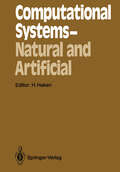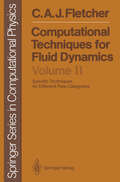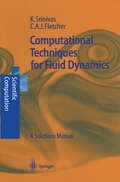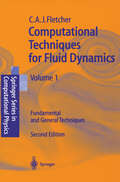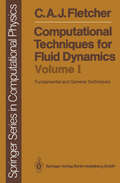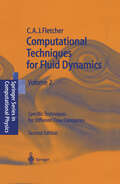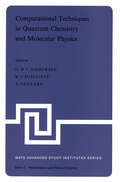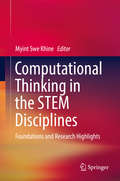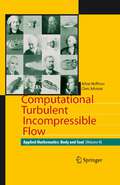- Table View
- List View
Computational Systems — Natural and Artificial: Proceedings of the International Symposium on Synergetics at Schloß Elmau, Bavaria, May 4–9, 1987 (Springer Series in Synergetics #38)
by Hermann HakenThis book contains the invited papers presented at an international sympo sium held at Schloss Elmau, Bavaria (FRG), May 4-9, 1987. Leading experts from neurobiology, medicine, physics, and the computer sciences joined to gether to present and discuss their most recent results. A particular example of the natural computational systems discussed is the visual system of man and animals. A bridge between neural networks and physical systems is provided by spin glass models of neural networks, which were also treated. Concrete realizations of new kinds of devices in microelectronics were among the further topics, as were general problems on the calculation of chaotic orbits. In this way these proceedings present a number of quite recent ap proaches to problems which are of great current interest in fields concerned with computational systems. Bringing together scientists from neurobiology, physics, and the computer sciences has been one of the main aims of the synergetics enterprise, and in particular of its international symposia, from the very beginning. For exam ple, its first meeting held in 1972 at Schloss Elmau included, among others, papers by R. Landauer and J. W. F. Woo on cooperative phenomena in data processing, by W. Reichardt on mechanisms of pattern recognition by the visual system of insects, by B. Julesz on stereoscopic depth perception, and by H. R. Wilson on cooperative phenomena in a homogeneous cortical tissue model. Whole meetings and the corresponding proceedings were devoted to these problems, e. g.
Computational Systems Biology Approaches in Cancer Research (Chapman & Hall/CRC Computational Biology Series)
by Inna Kuperstein Emmanuel BarillotPraise for Computational Systems BiologyApproaches in Cancer Research: "Complex concepts are written clearly and with informative illustrations and useful links. The book is enjoyable to read yet provides sufficient depth to serve as a valuable resource for both students and faculty." — Trey Ideker, Professor of Medicine, UC Xan Diego, School of Medicine "This volume is attractive because it addresses important and timely topics for research and teaching on computational methods in cancer research. It covers a broad variety of approaches, exposes recent innovations in computational methods, and provides acces to source code and to dedicated interactive web sites." — Yves Moreau, Department of Electrical Engineering, SysBioSys Centre for Computational Systems Biology, University of Leuven With the availability of massive amounts of data in biology, the need for advanced computational tools and techniques is becoming increasingly important and key in understanding biology in disease and healthy states. This book focuses on computational systems biology approaches, with a particular lens on tackling one of the most challenging diseases - cancer. The book provides an important reference and teaching material in the field of computational biology in general and cancer systems biology in particular. The book presents a list of modern approaches in systems biology with application to cancer research and beyond. It is structured in a didactic form such that the idea of each approach can easily be grasped from the short text and self-explanatory figures. The coverage of topics is diverse: from pathway resources, through methods for data analysis and single data analysis to drug response predictors, classifiers and image analysis using machine learning and artificial intelligence approaches. Features Up to date using a wide range of approaches Applicationexample in each chapter Online resources with useful applications’
Computational Systems Biology Approaches in Cancer Research (Chapman & Hall/CRC Computational Biology Series)
by Inna Kuperstein Emmanuel BarillotPraise for Computational Systems BiologyApproaches in Cancer Research: "Complex concepts are written clearly and with informative illustrations and useful links. The book is enjoyable to read yet provides sufficient depth to serve as a valuable resource for both students and faculty." — Trey Ideker, Professor of Medicine, UC Xan Diego, School of Medicine "This volume is attractive because it addresses important and timely topics for research and teaching on computational methods in cancer research. It covers a broad variety of approaches, exposes recent innovations in computational methods, and provides acces to source code and to dedicated interactive web sites." — Yves Moreau, Department of Electrical Engineering, SysBioSys Centre for Computational Systems Biology, University of Leuven With the availability of massive amounts of data in biology, the need for advanced computational tools and techniques is becoming increasingly important and key in understanding biology in disease and healthy states. This book focuses on computational systems biology approaches, with a particular lens on tackling one of the most challenging diseases - cancer. The book provides an important reference and teaching material in the field of computational biology in general and cancer systems biology in particular. The book presents a list of modern approaches in systems biology with application to cancer research and beyond. It is structured in a didactic form such that the idea of each approach can easily be grasped from the short text and self-explanatory figures. The coverage of topics is diverse: from pathway resources, through methods for data analysis and single data analysis to drug response predictors, classifiers and image analysis using machine learning and artificial intelligence approaches. Features Up to date using a wide range of approaches Applicationexample in each chapter Online resources with useful applications’
Computational Techniques for Econometrics and Economic Analysis (Advances in Computational Economics #3)
by D. A. BelsleyIt is unlikely that any frontier of economics/econometrics is being pushed faster, further than that of computational techniques. The computer has become a tool for performing as well as an environment in which to perform economics and econometrics, taking over where theory bogs down, allowing at least approximate answers to questions that defy closed mathematical or analytical solutions. Tasks may now be attempted that were hitherto beyond human potential, and all the forces available can now be marshalled efficiently, leading to the achievement of desired goals. Computational Techniques for Econometrics and Economic Analysis is a collection of recent studies which exemplify all these elements, demonstrating the power that the computer brings to the economic analysts. The book is divided into four parts: 1 -- the computer and econometric methods; 2 -- the computer and economic analysis; 3 -- computational techniques for econometrics; and 4 -- the computer and econometric studies.
Computational Techniques for Fluid Dynamics: Specific Techniques for Different Flow Categories (Springer Series in Computational Physics)
by Clive A. FletcherAs indicated in Vol. 1, the purpose of this two-volume textbook is to pro vide students of engineering, science and applied mathematics with the spe cific techniques, and the framework to develop skill in using them, that have proven effective in the various branches of computational fluid dy namics Volume 1 describes both fundamental and general techniques that are relevant to all branches of fluid flow. This volume contains specific tech niques applicable to the different categories of engineering flow behaviour, many of which are also appropriate to convective heat transfer. The contents of Vol. 2 are suitable for specialised graduate courses in the engineering computational fluid dynamics (CFD) area and are also aimed at the established research worker or practitioner who has already gained some fundamental CFD background. It is assumed that the reader is famil iar with the contents of Vol. 1. The contents of Vol. 2 are arranged in the following way: Chapter 11 de velops and discusses the equations governing fluid flow and introduces the simpler flow categories for which specific computational techniques are considered in Chaps. 14-18. Most practical problems involve computational domain boundaries that do not conveniently coincide with coordinate lines. Consequently, in Chap. 12 the governing equations are expressed in generalised curvilinear coordinates for use in arbitrary computational domains. The corresponding problem of generating an interior grid is considered in Chap. 13.
Computational Techniques for Fluid Dynamics: A Solutions Manual (Scientific Computation)
by Karkenahalli Srinivas Clive A.J. FletcherThis complementary text provides detailed solutions for the problems that appear in Chapters 2 to 18 of Computational Techniques for Fluid Dynamics (CTFD), Second Edition. Consequently there is no Chapter 1 in this solutions manual. The solutions are indicated in enough detail for the serious reader to have little difficulty in completing any intermediate steps. Many of the problems require the reader to write a computer program to obtain the solution. Tabulated data, from computer output, are included where appropriate and coding enhancements to the programs provided in CTFD are indicated in the solutions. In some instances completely new programs have been written and the listing forms part of the solution. All of the program modifications, new programs and input/output files are available on an IBM compatible floppy direct from C.A.J. Fletcher. Many of the problems are substantial enough to be considered mini-projects and the discussion is aimed as much at encouraging the reader to explore ex tensions and what-if scenarios leading to further dcvelopment as at providing neatly packaged solutions. Indeed, in order to givc the reader a better intro duction to CFD reality, not all the problems do have a "happy ending". Some suggested extensions fail; but the reasons for the failure are illuminating.
Computational Techniques for Fluid Dynamics 1: Fundamental and General Techniques (Scientific Computation)
by Clive A.J. FletcherThis well-known 2-volume textbook provides senior undergraduate and postgraduate engineers, scientists and applied mathematicians with the specific techniques, and the framework to develop skills in using the techniques in the various branches of computational fluid dynamics. A solutions manual to the exercises is in preparation.
Computational Techniques for Fluid Dynamics 1: Fundamental and General Techniques (Springer Series in Computational Physics)
by Clive A.J. FletcherThe purpose of this two-volume textbook is to provide students of engineer ing, science and applied mathematics with the specific techniques, and the framework to develop skill in using them, that have proven effective in the various branches of computational fluid dynamics (CFD). Volume 1 de scribes both fundamental and general techniques that are relevant to all branches of fluid flow. Volume 2 provides specific techniques, applicable to the different categories of engineering flow behaviour, many of which are also appropriate to convective heat transfer. An underlying theme of the text ist that the competing formulations which are suitable for computational fluid dynamics, e.g. the finite differ ence, finite element, finite volume and spectral methods, are closely related and can be interpreted as part of a unified structure. Classroom experience indicates that this approach assists, considerably, the student in acquiring a deeper understanding of the strengths and weaknesses of the alternative computational methods. Through the provision of 24 computer programs and associated exam ples and problems, the present text is also suitable for established research workers and practitioners who wish to acquire computational skills without the benefit of formal instruction. The text includes the most up-to-date techniques and is supported by more than 300 figures and 500 references.
Computational Techniques for Fluid Dynamics 2: Specific Techniques for Different Flow Categories (Scientific Computation)
by Clive A.J. FletcherThe purpose and organisation of this book are described in the preface to the first edition (1988). In preparing this edition minor changes have been made, par ticularly to Chap. 1 (Vol. 1) to keep it reasonably current, and to upgrade the treatment of specific techniques, particularly in Chaps. 12-14 and 16-18. How ever, the rest of the book (Vols. 1 and 2) has required only minor modification to clarify the presentation and to modify or replace individual problems to make them more effective. The answers to the problems are available in Solutions Manual jor Computational Techniques jor Fluid Dynamics by K. Srinivas and C. A. J. Fletcher, published by Springer-Verlag, Heidelberg, 1991. The computer programs have also been reviewed and tidied up. These are available on an IBM compatible floppy disc direct from the author. I would like to take this opportunity to thank the many readers for their usually generous comments about the first edition and particularly those readers who went to the trouble of drawing specific errors to my attention. In this revised edi tion considerable effort has been made to remove a number of minor errors that had found their way into the original. I express the hope that no errors remain but welcome communication that will help me improve future editions. In preparing this revised edition I have received considerable help from Dr. K.
Computational Techniques for the Summation of Series
by Anthony Sofo"This book collects in one volume the author’s considerable results in the area of the summation of series and their representation in closed form, and details the techniques by which they have been obtained... the calculations are given in plenty of detail, and closely related work which has appeared in a variety of places is conveniently collected together." --The Australian Mathematical Society Gazette
Computational Techniques in Quantum Chemistry and Molecular Physics: Proceedings of the NATO Advanced Study Institute held at Ramsau, Germany, 4–21 September, 1974 (Nato Science Series C: #15)
by Geerd H. F. Diercksen B. T. Sutcliffe A. VeillardThis book contains the transcripts of the lectures presented at the NATO Advanced study Institute on "Computational Techniques in Quantum Chemistry and Molecular Physics", held at Ramsau, Germany, 4th - 21st Sept. 1974. Quantum theory was developed in the early decades of this century and was first applied to problems in chemistry and molecular physics as early as 1927. It soon emerged however, that it was impossible to con sider any but the simplest systems in any quantita tive detail because of the complexity of Schrodinger's equation which is the basic equation for chemical and molecular physics applications. This remained the si tuation until the development, after 1950, of elec tronic digital computers. It then became possible to attempt approximate solutions of Schrodinger's equa tion for fairly complicated systems, to yield results which were sufficiently accurate to make comparison with experiment meaningful. Starting in the early nineteen sixties in the United States at a few centres with access to good computers an enormous amount of work went into the development and implementation of schemes for approximate solu tions of Schrodinger's equation, particularly the de velopment of the Hartree-Fock self-consistent-field scheme. But it was soon found that the integrals needed for application of the methods to molecular problems are far from trivial to evaluate and cannot be easily approximated.
Computational Techniques of the Simplex Method (International Series in Operations Research & Management Science #61)
by István MarosComputational Techniques of the Simplex Method is a systematic treatment focused on the computational issues of the simplex method. It provides a comprehensive coverage of the most important and successful algorithmic and implementation techniques of the simplex method. It is a unique source of essential, never discussed details of algorithmic elements and their implementation. On the basis of the book the reader will be able to create a highly advanced implementation of the simplex method which, in turn, can be used directly or as a building block in other solution algorithms.
Computational Theory of Mind for Human-Machine Teams: First International Symposium, ToM for Teams 2021, Virtual Event, November 4–6, 2021, Revised Selected Papers (Lecture Notes in Computer Science #13775)
by Nikolos Gurney Gita SukthankarThis book constitutes the proceedings of the First International Symposium, ToM for Teams 2021, held in Washington, DC, USA, during November 4–6, 2021, Each chapter in this section tackles a different aspect of AI representing the thoughts and beliefs of human agents. The work presented herein represents our collective efforts to better understand ToM, develop AI with ToM capabilities (ASI), and study how to integrate such systems into human teams.
Computational Thinking and Social Science: Combining Programming, Methodologies and Fundamental Concepts
by Matti NelimarkkaWhilst providing a fundamental understanding of computational social science, this book delves into the tools and techniques used to build familiarity with programming and gain context into how, why and when they are introduced. The overall focus is on helping you understand and design computational social science research, alongside delving into hands-on coding and technical instruction. Key features include: Further reading Exercises accompanied by sample code Programming examples in Scratch, Python and R Key concepts Chapter summaries With experience in course design and teaching, Matti Nelimarkka has a deep understanding of learning techniques within computational social sciences, with the main aim of blending researching, thinking and designing together to gain a grounded foundation for coding, programming, methodologies and key concepts.
Computational Thinking and Social Science: Combining Programming, Methodologies and Fundamental Concepts
by Matti NelimarkkaWhilst providing a fundamental understanding of computational social science, this book delves into the tools and techniques used to build familiarity with programming and gain context into how, why and when they are introduced. The overall focus is on helping you understand and design computational social science research, alongside delving into hands-on coding and technical instruction. Key features include: Further reading Exercises accompanied by sample code Programming examples in Scratch, Python and R Key concepts Chapter summaries With experience in course design and teaching, Matti Nelimarkka has a deep understanding of learning techniques within computational social sciences, with the main aim of blending researching, thinking and designing together to gain a grounded foundation for coding, programming, methodologies and key concepts.
Computational Thinking and Social Science: Combining Programming, Methodologies and Fundamental Concepts
by Matti NelimarkkaWhilst providing a fundamental understanding of computational social science, this book delves into the tools and techniques used to build familiarity with programming and gain context into how, why and when they are introduced. The overall focus is on helping you understand and design computational social science research, alongside delving into hands-on coding and technical instruction. Key features include: Further reading Exercises accompanied by sample code Programming examples in Scratch, Python and R Key concepts Chapter summaries With experience in course design and teaching, Matti Nelimarkka has a deep understanding of learning techniques within computational social sciences, with the main aim of blending researching, thinking and designing together to gain a grounded foundation for coding, programming, methodologies and key concepts.
Computational Thinking for the Modern Problem Solver (Chapman And Hall/crc Textbooks In Computing Ser.)
by David RileyThrough examples and analogies, Computational Thinking for the Modern Problem Solver introduces computational thinking as part of an introductory computing course and shows how computer science concepts are applicable to other fields. It keeps the material accessible and relevant to noncomputer science majors.With numerous color figures, this class
Computational Thinking in the STEM Disciplines: Foundations and Research Highlights
by Myint Swe KhineThis book covers studies of computational thinking related to linking, infusing, and embedding computational thinking elements to school curricula, teacher education and STEM related subjects. Presenting the distinguished and exemplary works by educators and researchers in the field highlighting the contemporary trends and issues, creative and unique approaches, innovative methods, frameworks, pedagogies and theoretical and practical aspects in computational thinking. A decade ago the notion of computational thinking was introduced by Jeannette Wing and envisioned that computational thinking will be a fundamental skill that complements to reading, writing and arithmetic for everyone and represents a universally applicable attitude. The computational thinking is considered a thought processes involved in a way of solving problems, designing systems, and understanding human behaviour. Assimilating computational thinking at young age will assist them to enhance problem solving skills, improve logical reasoning, and advance analytical ability - key attributes to succeed in the 21st century. Educators around the world are investing their relentless effort in equipping the young generation with real-world skills ready for the demand and challenges of the future. It is commonly believed that computational thinking will play a pivotal and dominant role in this endeavour. Wide-ranging research on and application of computational thinking in education have been emerged in the last ten years. This book will document attempts to conduct systematic, prodigious and multidisciplinary research in computational thinking and present their findings and accomplishments.
Computational Topology in Image Context: 6th International Workshop, CTIC 2016, Marseille, France, June 15-17, 2016, Proceedings (Lecture Notes in Computer Science #9667)
by Alexandra Bac Jean-Luc MariThis book constitutes the proceedings of the 6th International Workshop on Computational Topology in Image Context, CTIC 2016, held in Marseille, France, in June 2016. The 24 papers presented in this volume were carefully reviewed and selected from 35 submissions. Additionally, this volume contains 2 invited papers. CTIC covers a wide range of topics such as: topological invariants and their computation, homology, cohomology, linking number, fundamental groups; algorithm optimization in discrete geometry, transfer of mathematical tools, parallel computation in multi-dimensional volume context, hierarchical approaches; experimental evaluation of algorithms and heuristics; combinatorial or multi-resolution models; discrete or computational topology; geometric modeling guided by topological constraints; computational topological dynamics; and use of topological information in discrete geometry applications.
Computational Topology in Image Context: 4th International Workshop, CTIC 2012, Bertinoro, Italy, May 28-30, 2012, Proceedings (Lecture Notes in Computer Science #7309)
by Massimo Ferri Patrizio Frosini Claudia Landi Andrea Cerri Barbara Di FabioThis book constitutes the proceedings of the 4th International Workshop on Computational Topology in Image Context, CTIC 2012, held in Bertinoro, Italy, in May 2012. The 16 papers presented in this volume were carefully reviewed and selected for inclusion in this book. They focus on the topology and computation in image context. The workshop is devoted to computational methods using topology for the analysis and comparison of images. The involved research fields comprise computational topology and geometry, discrete topology and geometry, geometrical modeling, algebraic topology for image applications, and any other field involving a geometric-topological approach to image processing.
Computational Transport Phenomena of Fluid-Particle Systems (Mechanical Engineering Series)
by Hamid Arastoopour Dimitri Gidaspow Emad AbbasiThis book concerns the most up-to-date advances in computational transport phenomena (CTP), an emerging tool for the design of gas-solid processes such as fluidized bed systems. The authors examine recent work in kinetic theory and CTP and illustrate gas-solid processes’ many applications in the energy, chemical, pharmaceutical, and food industries. They also discuss the kinetic theory approach in developing constitutive equations for gas-solid flow systems and how it has advanced over the last decade as well as the possibility of obtaining innovative designs for multiphase reactors, such as those needed to capture CO2 from flue gases. Suitable as a concise reference and a textbook supplement for graduate courses, Computational Transport Phenomena of Gas-Solid Systems is ideal for practitioners in industries involved with the design and operation of processes based on fluid/particle mixtures, such as the energy, chemicals, pharmaceuticals, and food processing.
Computational Turbulent Incompressible Flow: Applied Mathematics: Body and Soul 4
by Johan Hoffman Claes JohnsonThis is Volume 4 of the book series of the Body and Soul mathematics education reform program. It presents a unified new approach to computational simulation of turbulent flow starting from the general basis of calculus and linear algebra of Vol 1-3. The book puts the Body and Soul computational finite element methodology in the form of General Galerkin (G2) up against the challenge of computing turbulent solutions of the inviscid Euler equations and the Navier-Stokes equations with small viscosity. This is an outstanding textbook presenting plenty of new material with an excellent pedagogical approach.
Computational Vision and Medical Image Processing V: Proceedings of the 5th Eccomas Thematic Conference on Computational Vision and Medical Image Processing (VipIMAGE 2015, Tenerife, Spain, October 19-21, 2015)
by Joao Manuel R. S. Tavares R. M. Natal JorgeVipIMAGE 2015 contains invited lectures and full papers presented at VIPIMAGE 2015 - V ECCOMAS Thematic Conference on Computational Vision and Medical Image Processing (Tenerife, Canary Islands, Spain, 19-21 October, 2015). International contributions from 19 countries provide a comprehensive coverage of the current state-of-the-art in the fields o
Computational Wave Propagation (The IMA Volumes in Mathematics and its Applications #86)
by Björn Engquist Gregory A. KriegsmannThis IMA Volume in Mathematics and its Applications COMPUTATIONAL WAVE PROPAGATION is based on the workshop with the same title and was an integral part of the 1994-1995 IMA program on "Waves and Scattering." We would like to thank Bjorn Engquist and Gregory A. Kriegsmann for their hard work in organizing this meeting and in editing the proceedings. We also take this opportunity to thank the National Science Foundation, the Army Research Office, and the Office of Naval Research, whose financial support made this workshop possible. A vner Friedman Robert Gulliver v PREFACE Although the field of wave propagation and scattering has its classical roots in the last century, it has enjoyed a rich and vibrant life over the past 50 odd years. Scientists, engineers, and mathematicians have devel oped sophisticated asymptotic and numerical tools to solve problems of ever increasing complexity. Their work has been spurred on by emerging and maturing technologies, primarily concerned with the propagation and reception of information, and the efficient transmission of energy. The vitality of this scientific field is not waning. Increased demands to precisely quantify, measure, and control the propagation and scattering of waves in increasingly complex settings pose challenging scientific and mathematical problems. These push the envelope of analysis and comput ing, just as their forerunners did 50 years ago. These modern technological problems range from using underwater sound to monitor and predict global warming, to periodically embedding phase-sensitive amplifiers in optical fibers to insure long range digital communication.
Computationally Intensive Statistics for Intelligent IoT (Studies in Autonomic, Data-driven and Industrial Computing)
by Debabrata Samanta Amit BanerjeeThe book covers computational statistics, its methodologies and applications for IoT device. It includes the details in the areas of computational arithmetic and its influence on computational statistics, numerical algorithms in statistical application software, basics of computer systems, statistical techniques, linear algebra and its role in optimization techniques, evolution of optimization techniques, optimal utilization of computer resources, and statistical graphics role in data analysis. It also explores computational inferencing and computer model's role in design of experiments, Bayesian analysis, survival analysis and data mining in computational statistics.
